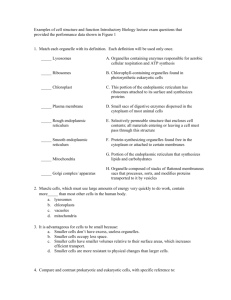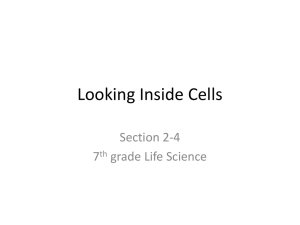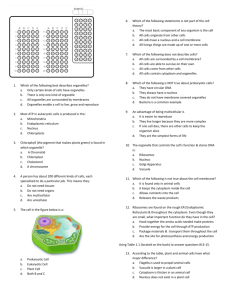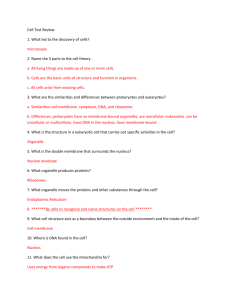Unit 2 Review
advertisement
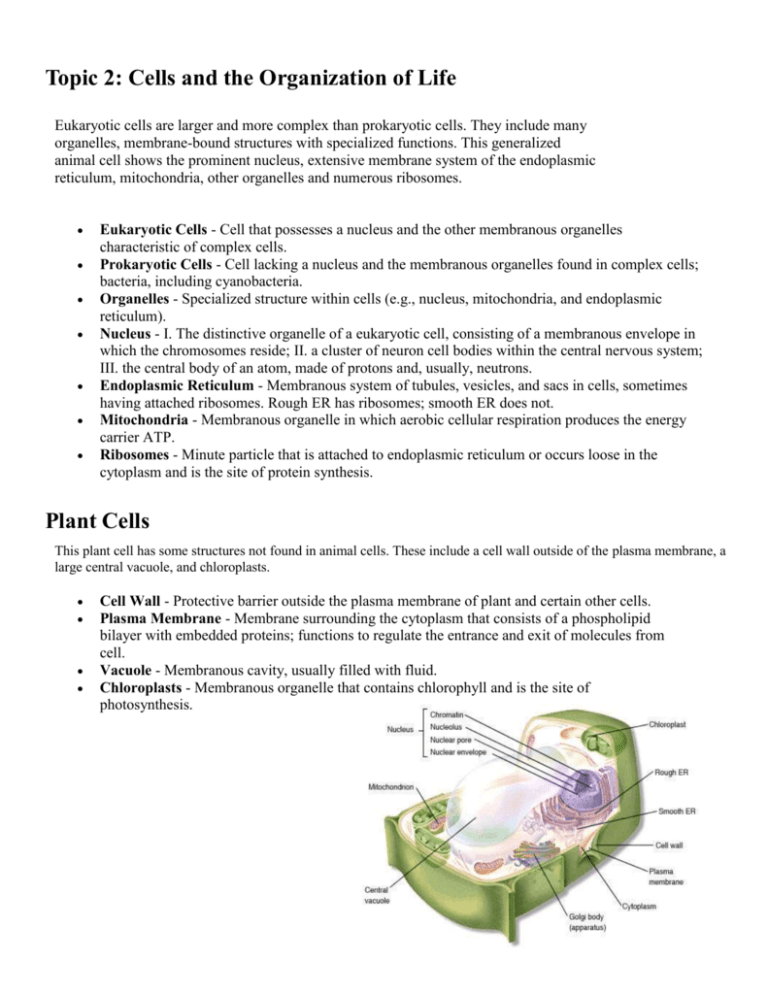
Topic 2: Cells and the Organization of Life Eukaryotic cells are larger and more complex than prokaryotic cells. They include many organelles, membrane-bound structures with specialized functions. This generalized animal cell shows the prominent nucleus, extensive membrane system of the endoplasmic reticulum, mitochondria, other organelles and numerous ribosomes. Eukaryotic Cells - Cell that possesses a nucleus and the other membranous organelles characteristic of complex cells. Prokaryotic Cells - Cell lacking a nucleus and the membranous organelles found in complex cells; bacteria, including cyanobacteria. Organelles - Specialized structure within cells (e.g., nucleus, mitochondria, and endoplasmic reticulum). Nucleus - I. The distinctive organelle of a eukaryotic cell, consisting of a membranous envelope in which the chromosomes reside; II. a cluster of neuron cell bodies within the central nervous system; III. the central body of an atom, made of protons and, usually, neutrons. Endoplasmic Reticulum - Membranous system of tubules, vesicles, and sacs in cells, sometimes having attached ribosomes. Rough ER has ribosomes; smooth ER does not. Mitochondria - Membranous organelle in which aerobic cellular respiration produces the energy carrier ATP. Ribosomes - Minute particle that is attached to endoplasmic reticulum or occurs loose in the cytoplasm and is the site of protein synthesis. Plant Cells This plant cell has some structures not found in animal cells. These include a cell wall outside of the plasma membrane, a large central vacuole, and chloroplasts. Cell Wall - Protective barrier outside the plasma membrane of plant and certain other cells. Plasma Membrane - Membrane surrounding the cytoplasm that consists of a phospholipid bilayer with embedded proteins; functions to regulate the entrance and exit of molecules from cell. Vacuole - Membranous cavity, usually filled with fluid. Chloroplasts - Membranous organelle that contains chlorophyll and is the site of photosynthesis. Animal Cell Review Eukaryotic Cells - Cell that possesses a nucleus and the other membranous organelles characteristic of complex cells. Prokaryotic Cells - Cell lacking a nucleus and the membranous organelles found in complex cells; bacteria, including cyanobacteria. Organelles - Specialized structure within cells (e.g., nucleus, mitochondria, and endoplasmic reticulum). Nucleus - I. The distinctive organelle of a eucaryotic cell, consisting of a membranous envelope in which the chromosomes reside; II. a cluster of neuron cell bodies within the central nervous system; III. the central body of an atom, made of protons and, usually, neutrons. Endoplasmic Reticulum - Membranous system of tubules, vesicles, and sacs in cells, sometimes having attached ribosomes. Rough ER has ribosomes; smooth ER does not. Mitochondria - Membranous organelle in which aerobic cellular respiration produces the energy carrier ATP. Ribosomes - Minute particle that is attached to endoplasmic reticulum or occurs loose in the cytoplasm and is the site of protein synthesis. Golgi apparatus – Stacked set of membranes that modifies, transports, and packages materials for export Organization of Life: Life is organized in ways from the simplest to the complex. At the multicellular level, specialized cells develop in such a manner where they structure (shape) helps them better perform a specific function (their job).

